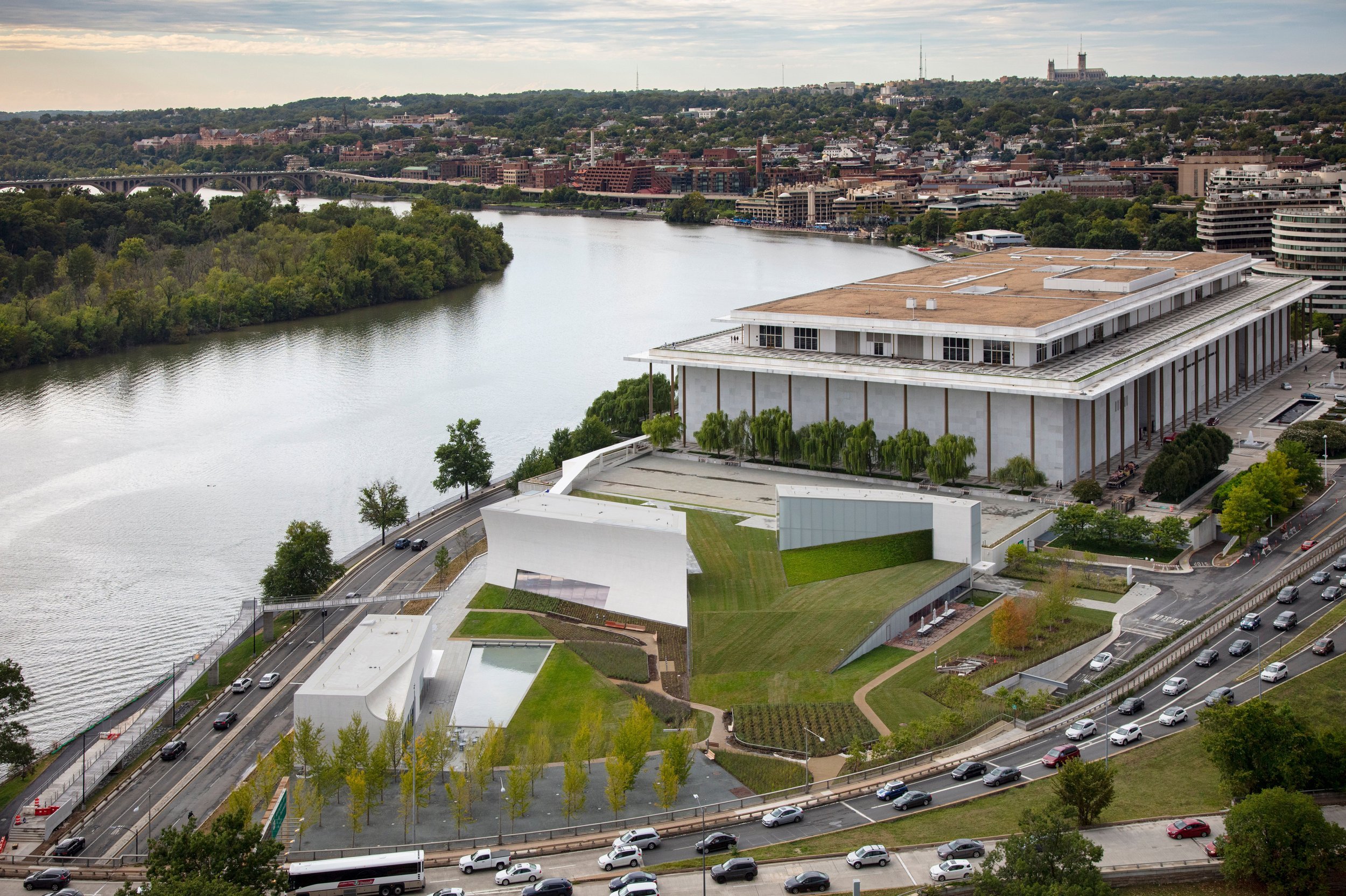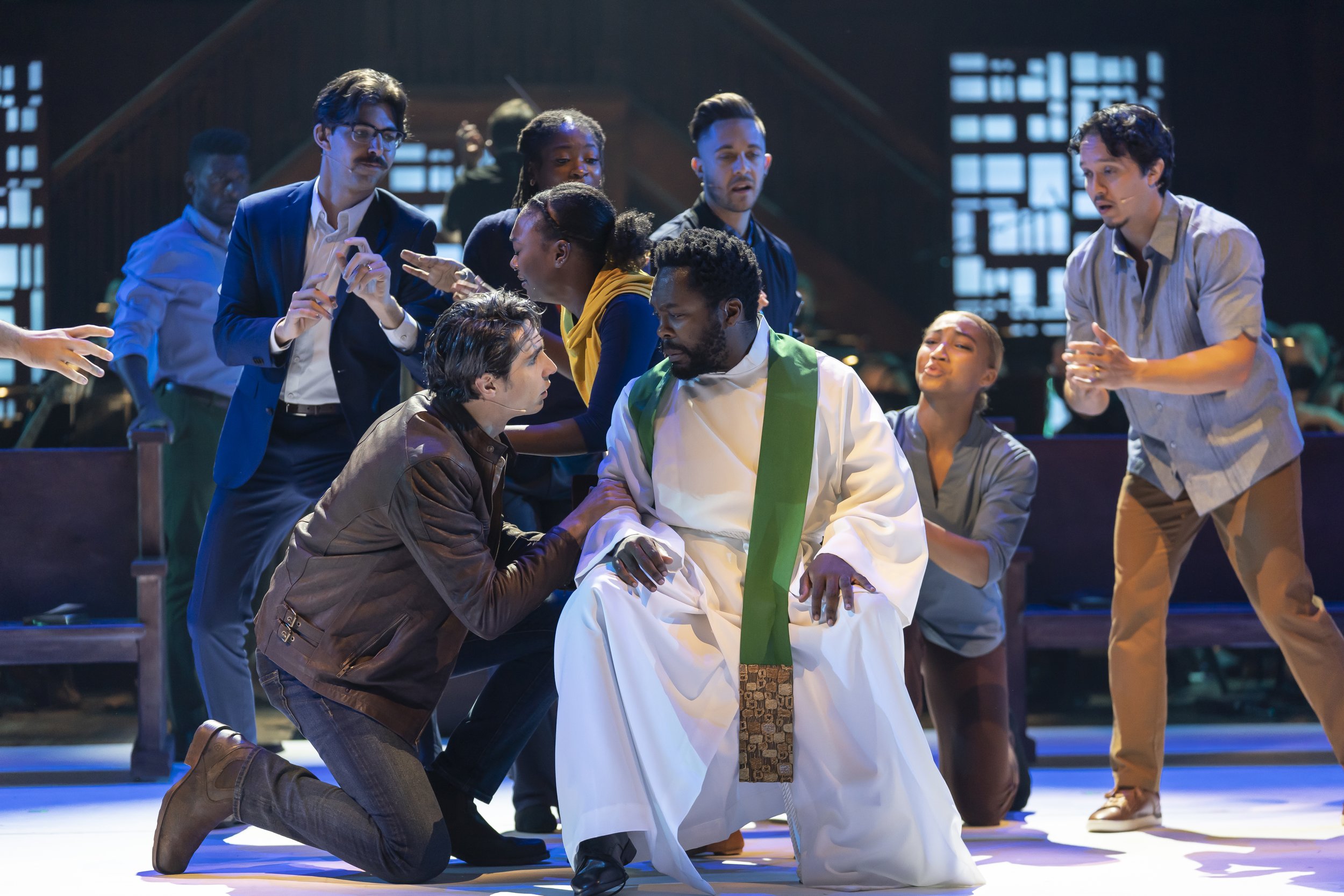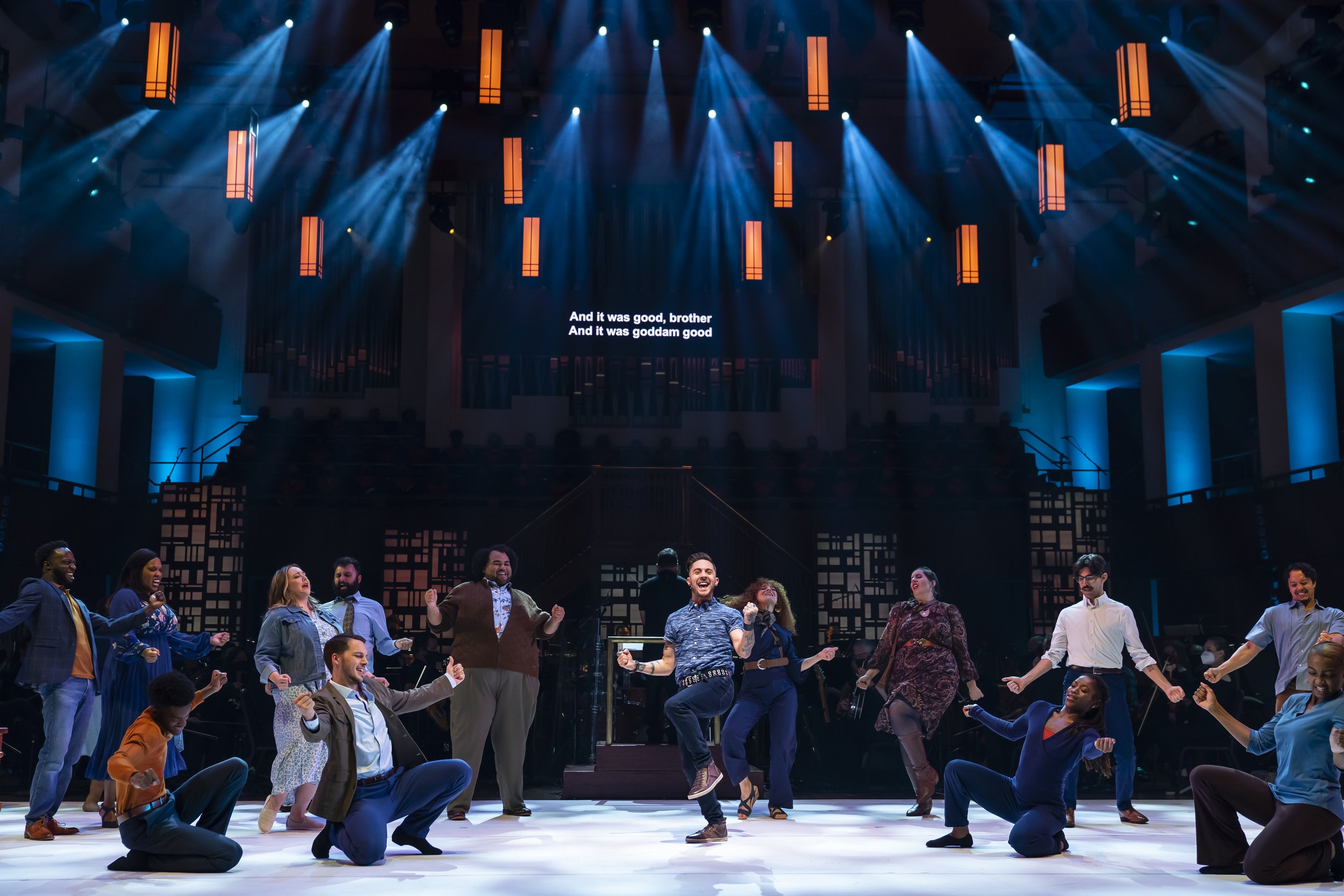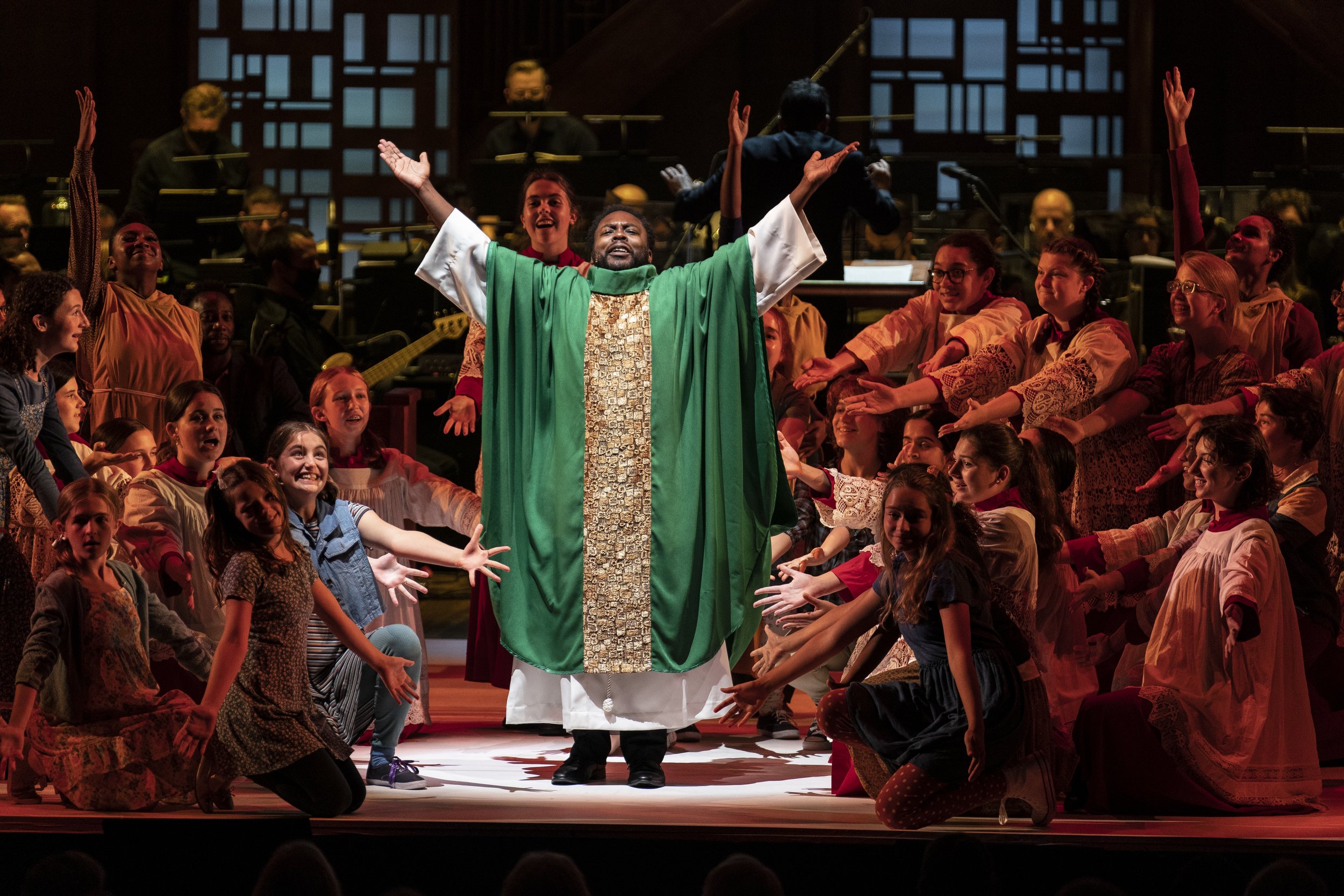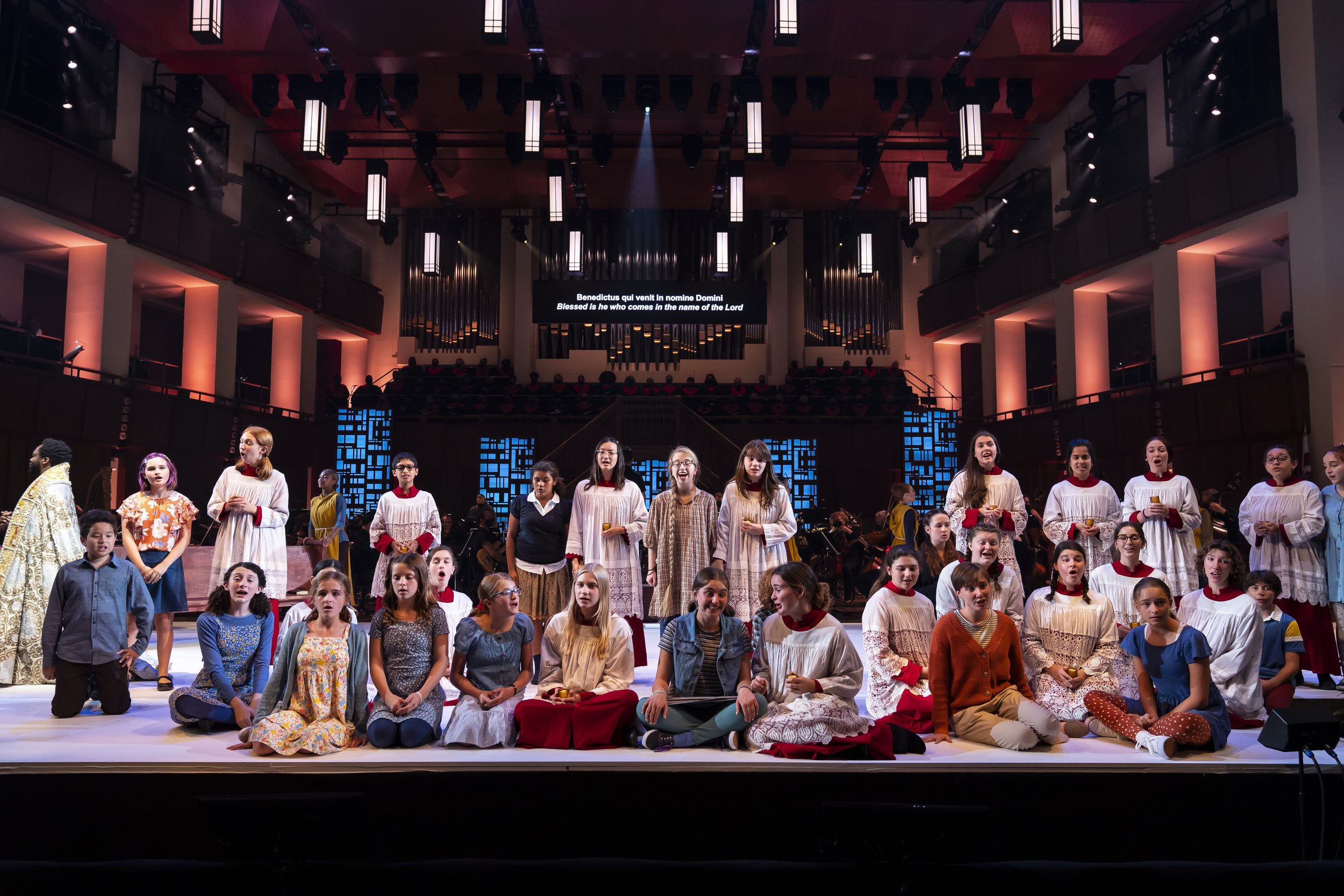For me, Leonard Bernstein, the arts, the Kennedy Center…well, it’s personal. David M. Rubenstein, Chairman of the Kennedy Center stated in the program notes that “Tonight’s performance of MASS celebrates not only the Kennedy Center, but the important role the arts and artists play in America, and will continue to play for years to come.” While commonly referred to as Bernstein’s Mass, the composer formally named it “MASS: A Theatre Piece for Singers, Players, and Dancers”. The three performances this past week were the last event in the Kennedy Center’s 50th anniversary celebration; the pandemic caused the delay to Center’s 51st year.
Photo 1: Aerial view of the John F. Kennedy Center for the Performing Arts today. Photo by Richard Barnes; courtesy of the Kennedy Center. Photo 2: Composer Leonard Bernstein at the first performance of his work, MASS: A Theatre Piece for Singers, Players, and Dancers, the inaugural performance event of the Kennedy Center on September 8, 1971. Photo by Fletcher Drake; courtesy of the Kennedy Center.
Why are the arts and artists important? I devoted my working life to scientific research and administration, medicinal chemistry to be specific, but in my retirement, I am exercising another part of my brain by writing an opera blog. Why? If I discover the answer to that question, I will report it. But it has made me think about the importance of the arts, and here is where I am with that: science allows us to see our physical world and find the relationships between its parts, enabling us greater control in meeting our needs. The arts I see as addressing the human question of who are we, really. The arts allow us to see what is important to us as humans, to find our common ground in a way that is experiential but non-confrontational, and through the arts’ ability to find great beauty in form and truth, art becomes a cohesive force for humanity. My son, the philosopher, says that science teaches us how to control our world while the arts teach us how to control ourselves. The ancient Greek philosophers pointed out that art, and in particular music, is fundamental to a healthy society. As Bernstein’s MASS calls for peace and coming together, all art has the effect of calling for peace by leading us to see ourselves in others and connect or re-connect with what is truly important in our lives.
Will Liverman as the Celebrant, surrounded by dancers in Bernstein’s MASS. Photo by Scott Suchman; courtesy of the Kennedy Center.
Why are discussions of Leonard Bernstein, a famous composer, conductor, and pianist personal to me? Growing up, my family and friends were not into classical music; enjoying classical music for me was a lonely pursuit, but I could watch Mr. Bernstein’s television programs where he not only played and conducted classical music, he also explained classical music. Looking back, while many classical music composers of the 20th century decided to write music for the sake of music, which appealed to a diminishing group, Mr. Bernstein was trying to maintain the connection with a more mainstream American audience. I even watched one program where he explained the creativity and appeal of the Beatle’s songs and music. The Kennedy Center and Mr. Bernstein’s stature as a composer were oblivious to this young Georgia boy at that time; all I knew was that I liked classical music, and he was helping me to connect with it. He is a bit of a hero, and oh yeah, he composed one of my favorite Broadway musicals, West Side Story.
How did Leonard Bernstein become so connected to the Kennedy Center? His genius, humanitarian efforts, and support of President Kennedy were widely recognized. In the late sixties, the assassinated president’s widow Jacqueline Kennedy invited him to compose a work for the inauguration of the newly commissioned United States National Cultural Center which was still under construction, which in 1964 had received the name of The John F. Kennedy Center for the Performing Arts, a memorial tribute to President Kennedy and his legacy, especially Kennedy’s strong support for the arts as a necessity for the spiritual health of the nation. Composer Bernstein, who had devoted one of his symphonies to JFK’s memory and later conducted the funeral service for his brother Robert F. Kennedy, accepted the assignment which included a deadline; his new work premiered on the Kennedy Center’s opening night. On September 8, 1971, this musical genius and extraordinary humanitarian offered up a fully-staged pageant of the arts, a musical wrapped around a mass as a celebration of a president’s legacy and the creation of the new National Cultural Center – the Kennedy Center.
Photo 1: Will Liverman with Soloists and dancers. Photo 2: Street People Ensemble members, Soloists, and dancers. Photo by Scott Suchman; courtesy of the Kennedy Center.
Why a mass? JFK was a Roman Catholic; a new work built around a mass seemed appropriate, especially since he was the first member of the Catholic faith to be elected president. This was also to be a celebration of the arts and the new center and its mission. Rather than adhering strictly to the seventeen sections of the Tridentine Catholic Mass, Mr. Bernstein added secular text and music and dance; the musical works its way through the sections of the mass including its liturgy in the libretto. Maestro Bernstein began work on the assignment in 1969, but when he began to feel deadline pressure in the spring of 1971, he recruited Steven Schwartz, known for the musical Godspell to work on the libretto with him. They constructed a story centering on the Celebrant, a priest, who undergoes a crisis of faith in response to the existential crises of his flock and their questioning of God coupled with issues tearing apart society in the turbulent 1960s, especially conflicts over the Vietnam War. In a very real sense, this work remains current and can be viewed as addressing present day issues.
Photo 1: Will Liverman and members of the Children’s Chorus of Washington. Photo 2: The Children’s Chorus of Washington. Photos by Scott Suchman; courtesy of the Kennedy Center.
The Kennedy Center performance of Mass on Saturday night was my first viewing of this work. It is said that opera should overwhelm the senses. By that criterion, Mass met the definition of opera; it also met the definition of wow! There was staging, lighting and color shadings, storytelling, drama, costumes, music, singing, and dancing. The vocal and musical styles switched often and easily among tonal and atonal classical music, rock, jazz, blues, and Broadway, with live music sometimes augmented by recorded music and singing. Words were in Latin, Hebrew, and English. There was gentle, soulful singing and quiet musical meditations between twelve tone clashes of voices and discordant music, music to support the liturgical procession and music to support the existential angst and angry clashes. There was a lead singer, twelve street singer soloists, a street people ensemble, a children’s choir, an adult choir, dancers, and a full orchestra. Two hundred and ten performers filled the stage of the Kennedy Center’s Concert Hall and the balcony back of the stage and spilled out into the audience. The mission of the Kennedy Center to support the arts broadly was embodied in Mr. Bernstein’s massive work. If rap music had been a thing in the sixties, I’m sure Maestro Bernstein would have employed it. (Hmmm, I wonder if Lin-Manuel Miranda might be interested in doing a version; KC will likely have a 60th year anniversary celebration).
Performances in KC’s production were uniformly excellent; however only one role has the spotlight for very long, the Celebrant around whom the action rotates; the actor/singer must evidence simple faith yielding to doubt, then a breakdown, and rebirth. The reception of MASS absolutely depends on the singer who plays the Celebrant. Fortunately, baritone Will Liverman was more than equal to the task; his performance was a tour-de-force. The beautiful timber and power of his voice shone from the beginning, and he played the role as though it had been written for him. I expected him to be good; he was great. The street people soloists all sang well and delivered their songs with conviction. The singers of the tropes questioning God and their faith were particularly effective.
The National Symphony Orchestra on stage led by Conductor James Gaffigan and in the balcony, the Heritage Signature Chorale led by Artistic Director Stanley J. Thurston. Photo by Scott Suchman; courtesy of the Kennedy Center.
Kudos to Conductor James Gaffigan and the National Symphony Orchestra who managed to make this mélange of styles work with instrument pairings from full orchestra to individual solo accompaniments such as oboe and flute. The dancers and the choreography were excellently woven into the drama; kudos to choreographer Hope Boykin. The Heritage Signature Chorale was outstanding. The Children’s Chorus of Washington led by Artistic Director Margaret Nomura Clark and the child soloists were excellent and added the element of innocence, especially in the closing “Simple Song” as the spent congregation revives, and reclaims their faith. The ending seemed honest to me – after weathering the storm, though not resolving their issues, the people returned to a simple belief in God.
Director Alison Moritz worked with Conductor Gaffigan to update the work to the present day and chose the inside of a church for the setting. Their work made this a memorable production. After its initial performance in 1971, it was both praised and assailed by critics. It was attacked by Catholic leaders and then later performed at the Vatican. President Nixon declined to attend due to its presumed anti-war viewpoint. Yet, the work remains relevant; over forty performances were staged worldwide in 2017-2018 for the 100th anniversary of Leonard Bernstein’s birth. At its premiere, the MASS received a standing ovation. At Saturday night’s performance, the entire, packed house audience, as far as I could see, rose to its feet in unison to clap and cheer. I can understand the criticisms of the work and see where they are relevant, or not, but after viewing just one performance I feel grateful for having seen it, both as an engaging work of art and as a piece of history close to my heart. I think Leonard Bernstein achieved his goal of making the new U.S. National Culture Center stand out, and the Kennedy Center has made good on its mission to provide strong support for a broad spectrum of arts and artists. I am a Kennedy Center member; it’s personal.
The Fan Experience: This production of Bernstein’s MASS ran for three performances in the Kennedy Center’s Concert Hall on September 15, 17, and 18. The 2022-2023 season for the National Symphony begins on September 24 and the new season for Washington National Opera begins on October 22. Parking in the Kennedy Center is typically plentiful at around $25 per day. The Metro to Foggy Bottom and the free Red Kennedy Center buses from there to the Kennedy Center which run every 15 minutes are an excellent option. Always check with the venue of the performance you are attending for COVID restrictions; for Saturday’s performance, masking was still required, but not proof of vaccination.
Interested in reading more about the Kennedy Center’s production of MASS? Washington Post critic Michael Andor Brodeur has written excellent preview and review articles, and in a pleasant surprise, KC’s production of MASS led former Post critic, Anne Midgette, to write her first review since leaving the Post to explore what this work has meant to her and how it has changed over time, posted on her website.
Coinciding with the performances of the MASS, the Kennedy Center opened a new permanent exhibition, “Arts and Ideals: President John F. Kennedy” in the JFK Gallery located on the Terrace Level. It covers President Kennedy from childhood to his death with a focus on his commitment to the arts; it includes a display on Bernstein’s Mass. We only had a few minutes to wander through but plan to spend more time there on our next trip down to KC.

